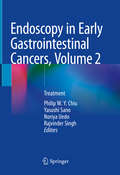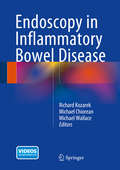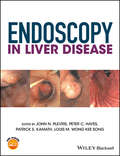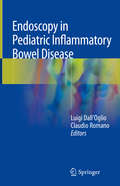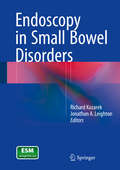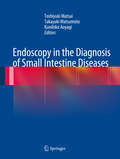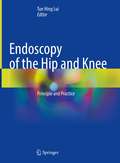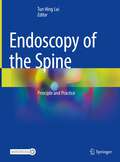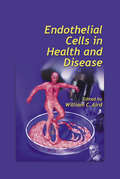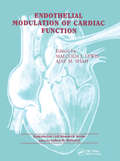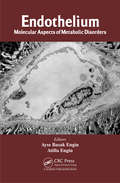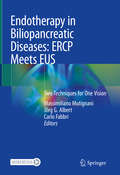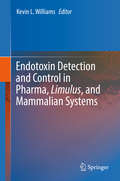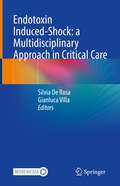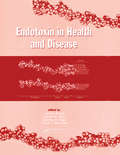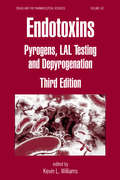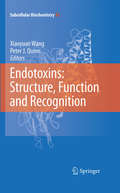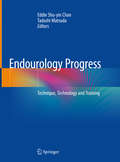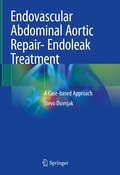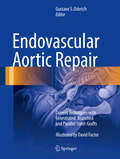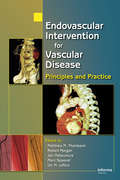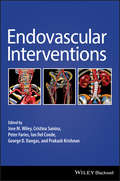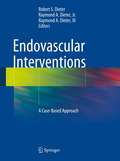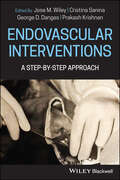- Table View
- List View
Endoscopy in Early Gastrointestinal Cancers, Volume 2: Treatment
by Yasushi Sano Philip W. Y. Chiu Noriya Uedo Rajvinder SinghEndoscopy in Early Gastrointestinal Cancers, Volume 2: Treatment covers the detailed information of the indications, techniques and perioperative management of endoscopic resection including endoscopic mucosal resection (EMR) and endoscopic submucosal dissection (ESD). Carcinoma of the gastrointestinal tract remained a major health issue worldwide, which is, however notoriously difficult to treat. Endoscopic resection for early neoplasia of the gastrointestinal tract had been developed for more than 25 years. Endoscopic submucosal dissection (ESD) is a recently developed technique pioneer by Japanese endoscopists. The principle of ESD is to achieve a complete resection of gastrointestinal neoplasia limited to mucosa with adequate circumferential margins. This novel endoscopic technique not only allows the achievement of en-bloc resection for early GI cancers, it also conveys a significantly lower rate of local recurrence as compared to EMR for early gastric cancers. There is an urge for the knowledge in applying these novel technologies for the treatment of early GI neoplasia worldwide. This book on the endoscopic treatment of early GI neoplasia, containing lots of illustrations, artwork and numerous short video clips, serves as a bridge between the recent development in endoscopy and the knowledge of gastroenterologist, endoscopist and surgeons.
Endoscopy in Inflammatory Bowel Disease
by Michael Wallace Richard Kozarek Michael ChioreanThis book conjoins the latest advances on the use of endoscopy to diagnose, monitor, and treat patients with inflammatory bowel disease. Chapters include the historical use of rigid sigmoidoscopy, non-interventional imaging procedures, and the correlation of pathology and endoscopic visualization. This is the first book to include individual chapters in gastroenterology, colorectal surgery, and IBD texts, the preeminent role of endoscopic imaging in the management of chronic ulcerative colitis, and Crohn's disease. It also includes chapters on capsule endoscopy and balloon and overtube-assisted enteroscopy to define the presence and activity of Crohn's enteritis and additional chapters defining the use of random biopsies versus chromoendoscopy, and computer enhanced imaging to define possible dysplasia development. The book also includes access to online videos, making it the ultimate verbal and visual tool for all medical professionals interested in the advances in the field over the last several decades. Endoscopy in Inflammatory Bowel Disease is a concise text that is of great value to practicing endoscopists, gastroenterologists, general or colorectal surgeons, physicians in training, and all medical professionals caring for patients with inflammatory bowel disease.
Endoscopy in Liver Disease
by John N. Plevris Peter C. Hayes Patrick S. Kamath Louis-Michel Wong SongLiver disease is an increasingly common cause of mortality, and its management is often complex and challenging. Endoscopy has in recent times undergone a period of rapid progress, with numerous novel and specialized endoscopic modalities that are of increasing value in the investigation and management of the patient with liver disease. As the technology in endoscopy expands, both as a diagnostic and interventional procedure, so does the role of the endoscopist in liver disease. This full colour book and companion website offer a comprehensive guidance as to when, why, and how to perform endoscopy to best manage your patients. Brings together two key areas - liver disease and endoscopy - into one expert clinical textbook Covers the entire spectrum of clinical problems that gastroenterologists and endoscopists face while managing patients with liver disease Includes the latest management guidelines from the key international societies, such as the ASGE, AASLD, EASL and BSG Well illustrated with over 150 high-quality colour images 11 high-quality videos illustrating optimum endoscopy practice, all clearly referenced in the text An indispensable tool for all gastroenterologists, hepatologists and endoscopists, Endoscopy in Liver Disease is perfect for learning how to perform endoscopy safely and effectively in the patient population with liver disorders.
Endoscopy in Pediatric Inflammatory Bowel Disease
by Claudio Romano Luigi Dall'OglioThis book describes an up-to-date practical strategy for the use of endoscopy in the evaluation and management of pediatric patients with inflammatory bowel disease (IBD). All aspects of the role of endoscopy in Crohn’s disease (CD) and ulcerative colitis (UC) – the two most common types of IBD – are addressed. Readers will find detailed information on its use in the initial diagnosis of IBD, differentiation between CD and UC, assessment of disease extent and activity, monitoring of response to therapy, and surveillance for cancer and dysplasia. Attention is drawn to specific clinical and endoscopic features of CD and UC in the pediatric age group that serve to illustrate why the child is not to be regarded merely as a small adult. Helpful information is also supplied on equipment, patient and parent preparation, and sedation. Endoscopy is considered the best means of obtaining a definite diagnosis in children who may have IBD, and this book will be of value to practitioners at all levels of experience.
Endoscopy in Small Bowel Disorders
by Richard Kozarek Jonathan A. LeightonThis volume reviews the history of endoscopy to diagnose small bowel disorders, places other diagnostic modalities into perspective, and defines the role of capsule endoscopy and per overtube assisted and retrograde enteroscopy in disorders as disparate as gluten sensitive enteropathy, small bowel neoplasms, and inflammatory bowel disease. The book further details the nonoperative approach to NSAID strictures, foreign body retrieval (to include impacted capsule endoscopes), and the diagnosis and treatment of chronically bleeding angiodysplastic lesions. The text is also richly illustrated with over 150 images and includes online video segments. Written by experts in the field, Endoscopy in Small Bowel Disorders is a valuable resource for medical and surgical residents, gastroenterologists in training and practice, therapeutic endoscopists, and general and colorectal surgeons.
Endoscopy in the Diagnosis of Small Intestine Diseases
by Toshiyuki Matsui Takayuki Matsumoto Kunihiko AoyagiThe purpose of this book is to improve diagnostic yields of capsule endoscopy and double-balloon endoscopy, because those procedures can depict nonspecific findings that may not lead to a proper diagnosis. Another reason for the publication was recognition of the difficulty in distinguishing enteroscopic findings of ulcerative colitis from those of Crohn's disease. From a practical point of view, it is important to observe endoscopic pictures first, then to compare the images of other modalities, and finally to compare macroscopic pictures of resected specimens. For that reason, a large number of well-depicted examples of small intestinal lesions were assembled to clarify differences among small intestinal lesions that appear to exhibit similar findings and morphologies. Comparisons with radiographic findings comprise another important element in diagnosis. There are limitations in endoscopic observations of gross lesions of the small intestine, with its many convolutions. In Japan, many institutions still practice double-contrast imaging, which provides beautiful results. Because a single disorder may exhibit variations, this volume includes multiple depictions of the same disorders. Also included are lesions in active and inactive phases, as both appearances are highly likely to be encountered simultaneously in clinical practice. The number of illustrated findings therefore has been limited to strictly selected cases.
Endoscopy of the Hip and Knee: Principle and Practice
by Tun Hing LuiThis book provides detailed advancement endoscopy procedures of hip and knee. It covers basic knowledge of procures and dedicated introduction of surgical techniques for disease management. Endoscopic procedures with their advantage in surgical exposure and post-operative rehabilitation have been extensively performed in orthopedic diseases. Cases presentation with well-illustrated arthroscopic and endoscopic photos for common clinical conditions was provided. The format is a step-by-step procedure for easy reference, particularly for surgeons in their training.
Endoscopy of the Spine: Principle and Practice
by Tun Hing LuiThis book provides detailed advancement of endoscopic procedures of the spine. It covers basic knowledge of endoscopic procedures and dedicated introduction of surgical techniques for treatment of diseases in spine with better surgical outcome and less surgical morbidity. Endoscopic procedures with their advantage in surgical exposure and post-operative rehabilitation have been extensively performed in orthopedic diseases. Cases presentation with well-illustrated endoscopic photos for common clinical conditions was provided. The format is a step-by-step procedure for easy reference, particularly for surgeons in their training.
Endoskopische Verfahren in der Mund-Kiefer-Gesichtschirurgie: Eine Einführung in das fachbezogene Spektrum (essentials)
by Andreas NeffAndreas Neff zeigt die exzellenten diagnostischen und therapeutischen Optionen der Endoskopie, die für den MKG-Chirurgen bei der komplexen Anatomie der Mund-Kiefer-Gesichtsregion, speziell der Kieferhöhlen und der Nasengänge, des Kiefergelenks, aber auch der Speicheldrüsen heute unverzichtbar ist. Minimalinvasive Darstellung und Zugänge gemäß State of the Art erfordern neben chirurgischem Know-how auch ein spezielles technisches Equipment. Während die Endoskopie in der MKG-Chirurgie meist speziellen Indikationen vorbehalten ist, hat sie insbesondere in der HNO inzwischen einen Großteil der traditionellen direkten bzw. invasiv-offenen Verfahren ersetzt. Auch in der MKG-Chirurgie wird es analog zu ihren Nachbardisziplinen zunehmend zu Paradigmenwechseln in der Behandlungsstrategie kommen, denen sich die MKG-Chirurgie stellen muss, um sich auch in Zukunft auf Augenhöhe weiterentwickeln zu können.
Endothelial Cells in Health and Disease
by William C. AirdThis reference serves as the first source to gather current data from endothelial cell biologists in various disciplines to summarize recent progress in the field-providing a complete understanding of the endothelium in health and disease and demonstrating its potential as a therapeutic target.
Endothelial Modulation of Cardiac Function (Endothelial Cell Research Ser.)
by Malcolm J Lewis Ajay M ShahParacrine and autocrine regulation of cardiac function by "endothelial" mediators is becoming important both physiologically and pathophysiologically. This volume brings the researcher completely up to date with all aspects of endothelial regulation and cardiac function. Acknowledged experts in each field have contributed, making this work indispensable for researchers and of great interest to the clinical cardiologist. The Endothelial Cell Research Series publishes significant reviews by experts in the field. The individual volumes provide invaluable guides to researchers studying endothelial cells and are effective reference texts for anyone working in the general areas of vascular biology and neurotransmission. Endothelium was originally considered to be an inert lining for the blood vessels, but during the last fifteen years, this view has had to be completely revised. It is now accepted that the endothelium plays an important role in many diverse functions. This volume concentrates on the effect of the endothelium on cardiac function. It has been widely demonstrated that the endothelium exerts a paracrine influence on contraction of adjacent cardiac muscle through the release of several mediators, such as endothelin and nitric oxide. Recent studies also show that the effects of such mediators upon the heart are not limited to contraction alone.
Endothelium: Molecular Aspects of Metabolic Disorders
by Atilla Engin Ayse Basak EnginThe function and life span of endothelial cells have a large impact upon the quality and expectancy of an individual's life. During low perfusion, the adaptation of different cells to hypoxia precipitate the aggressive progression of diseases. Although the clinical studies have convincingly shown that endothelial dysfunction occurs whenever the bio
Endotherapy in Biliopancreatic Diseases: Two Techniques for One Vision
by Massimiliano Mutignani Jörg G. Albert Carlo FabbriThis volume presents the technical and cultural state of the art of two of the riskiest, most complex and operator-dependent digestive operative techniques: endoscopic retrograde cholangiopancreatography (ERCP) and endoscopic ultrasonography (EUS). The authors compare old and new techniques, shedding light on the most recent and innovative scientific findings, including those in the field of anatomic pathology and molecular biology considered relevant for the analysis of tissue samples collected during EUS. In view of the technical difficulties specific to these techniques, the book also offers access to online-videos and numerous images, making it a valuable resource both for physicians approaching these techniques for the first time as well as for those already using them. Organized into 7 sections, it describes in detail all techniques related to ERCP/EUS, together with any specific technical equipment required. It also presents a new paradigm based on the latest results in the areas of prevention, diagnosis and management of the most common complications. Clinical outcomes presented in international literature, as well as algorithms – both based on scientific evidence and expert findings – are illustrated and compared to alternative treatments.
Endotoxin Detection and Control in Pharma, Limulus, and Mammalian Systems
by Kevin L. WilliamsEndotoxin detection and control is a dynamic area of applied science that touches a vast number of complex subjects. The intersection of test activities includes the use of an ancient blood system from an odd “living fossil” (Limulus). It is used to detect remnants of the most primitive and destructive forms of life (prokaryotes) as contaminants of complex modern systems (mammalian and Pharma). Recent challenges in the field include those associated with the application of traditional methods to new types of molecules and manufacturing processes. The advent of “at will” production of biologics in lieu of harvesting animal proteins has revolutionized the treatment of disease. While the fruits of the biotechnology revolution are widely acknowledged, the realization of the differences in the means of production and changes in the manner of control of potential impurities and contaminants in regard to the new versus the old are less widely appreciated. Endotoxin as an ancient, dynamic interface between lifeforms, provides a singular perspective from which to view the parallel development of ancient and modern organisms as well as the progress of man in deciphering the complexity of their interactions in his efforts to overcome disease.
Endotoxin Induced-Shock: a Multidisciplinary Approach in Critical Care
by Silvia De Rosa Gianluca VillaThis book provides easy consultation and guidance for an appropriate understanding and management of endotoxic shock. Endotoxic shock results from a severe, generalized inflammatory response induced by bloodstream infection with gram-negative bacteria. However, endotoxin-induced inflammatory activation may be disconnected by Gram-Negative threats (e.g. Gram-Positive and yeast infections) as well as occur in multiple clinical scenarios like post-cardiac arrest syndrome and trauma, possibly due to gut barrier dysfunction and consequent endotoxin translocation. The clinical management is structured focusing and dedicating a chapter for antibiotics, corticosteroids, volume support, vasoactive and cardiostimulating drug, coagulopathy and nutritional support. In addition, this book is remarkable because describing polymixin b hemoperfusion points out molecular interactions, and hydrodynamics of Sorption. Each section includes •) brief pathophysiology; •) principles of management; •) key messages. Readers can find updated tips related to the diagnosis and management of endotoxic shock with a multidisciplinary approach drawing a pathway from endotoxin structure and source and the related pathophysiology of endotoxic shock underling the specific clinical aspect and focusing on medical clinical management of endotoxemia and extracorporeal removal. The book – written by international opinion leaders of this field – is addressed to healthcare providers working in intensive care and represents a point of reference for intensivists, infectious disease physicians, nephrologists and critical care nurses involved in the management of endotoxic shock and enriched with useful downloadable material.
Endotoxin in Health and Disease
by Helmut Brade; Steven M. Opal; Stefanie N. Vogel; David C. MorrisonOffering a basis for further research into the interactions of hosts and pathogens, this work gathers up-to-date findings, and details basic structures, functions and immunology. It provides descriptions of a variety of experimental endotoxin neutralizing agents, as well as a guide to clinical research initiatives and the latest treatments.
Endotoxins: Pyrogens, LAL Testing and Depyrogenation (ISSN)
by Kevin L. WilliamsThis source expertly examines the discovery, biological structure, control, and continued clarification of endotoxin from a parenteral manufacturing perspective, with in-depth discussion of state-of-the-art technologies involving Limulus amebocyte lysate (LAL) such as assay development, automation, depyrogenation. Completely revised and exp
Endotoxins: Structure, Function and Recognition
by Peter J. Quinn Xiaoyuan WangEndotoxins are potentially toxic compounds produced by Gram-negative bacteria including some pathogens. Unlike exotoxins, which are secreted in soluble form by live bacteria, endotoxins are comprised of structural components of bacteria. Endotoxins can cause a whole-body inflammatory state, sepsis, leading to low blood pressure, multiple organ dysfunction syndrome and death. This book brings together contributions from researchers in the forefront of these subjects. It is divided into two sections. The first deals with how endotoxins are synthesized and end up on the bacterial surface. The second discussed how endotoxins activate TLR4 and, in turn, how TLR4 generates the molecular signals leading to infectious and inflammatory diseases. The way endotoxins interact with the host cells is fundamental to understanding the mechanism of sepsis, and recent research on these aspects of endotoxins has served to illuminate previously undescribed functions of the innate immune system. This volume presents a description of endotoxins according to their genetic constitution, structure, function and mode of interaction with host cells.
Endourology Progress: Technique, Technology And Training
by Eddie Shu-yin Chan Tadashi MatsudaThis book presents the work and development of endourology and the contribution of East Asian Society of Endourology. This book is intended to familiarize the modern urologists with the common endourology, laparoscopic and robotic urologic procedures and the development of technology, techniques and training. <p><p> The book is the collection of papers and presentations in Congress of East Asia Society of Endourology. Recognized experts in the field of endourology have contributed to share their experiences and opinions. It consists of latest update and advancement of surgical techniques, technology in minimal invasive surgery. The development of endoscopic, laparoscopic and robotic urological operations is reviewed. A whole session is dedicated to training in endourology are included. Detail descriptions of perioperative preparation, step-by-step surgical procedures and tips/tricks will be emphasized in the corresponding chapters, supplemented by photographs and illustrations. <p> In the first session, techniques on kidney, bladder and prostate surgeries are discussed. In the second session, is dedicated to the advances of new technologies in endourology. The third session covers the important areas of endourology training and the development of endourology. <p> This book is most suitable for urology residents and young fellows who are keen to start their endourological training. It also provides up-to-date information on current topics of endourology for practicing urologists and experienced endourologists.
Endovascular Abdominal Aortic Repair- Endoleak Treatment: A Case-based Approach
by Stevo DuvnjakThis book provides a comprehensive and practical overview of treatments for endovascular endoleaks, which represent the most frequent complications after endovascular abdominal aortic repair (EVAR). Written by a highly experienced interventional radiologist, it explains in practical terms the management of endoleaks using various embolization materials and different types of stent graft. Highlighting a range of typical and challenging cases, the book familiarizes readers with the various treatment options currently available. As such, it offers an invaluable practical guide for experienced endovascular specialists and beginners who need to treat patients with EVAR.
Endovascular Aortic Repair
by Gustavo S. OderichThis text provides a comprehensive, state-of-the art review of complex endovascular aortic techniques. It will serve as a valuable resource for vascular and cardiovascular surgeons, interventionalists, cardiologists, clinicians, bioengineers and researchers with an interest in complex aortic diseases. The book reviews imaging modalities, diagnostic work up and novel endovascular approaches. Technical aspects are provided by experts in the field, with over 600 illustrations and photographs of key steps for each type of procedure. Results of epidemiologic studies and national databases are summarized, as well as large institutional experiences. An evidence-based approach is used for recommendations regarding best therapies. Other highlights of this unique text include: A new, state-of-the-art review on fenestrated, branched and parallel stent-graft techniques from procedure planning to stent design and implantation. A text dedicated to a topic that has been increasingly recognized by vascular specialists as a priority area in aortic management. An updated overview of current designs and future developments. Special attention to technical details of the procedures with use of illustrations. Technical tips on how to get out of problems during these challenging procedures. Endovascular Aortic Repair: Current Techniques with Fenestrated, Branched and Parallel Stent-Grafts will serve as a very useful resource for physicians and researchers dealing with and interested in complex aortic diseases. It will provide a concise yet comprehensive summary of the current status of the field that will help guide patient management and stimulate investigative efforts. All chapters are written by experts in their fields and include the most up to date scientific and clinical information.
Endovascular Intervention for Vascular Disease: Principles and Practice
by Matt M. ThompsonHistorically, vascular disease has been treated by a combination of open surgical procedures and medical management. Since the first description of a percutaneous procedure to dilate diseased lower limb arteries, the treatment of vascular disease has changed. Endovascular Intervention for Vascular Disease: Principles and Practice offers a diverse a
Endovascular Interventions
by George D. Dangas Jose M. Wiley Cristina Sanina Peter Faries Ian Del Conde Prakash KrishnanA practical resource covering both elective and emergency procedures for the practicing vascular and endovascular clinician This book provides medical professionals (vascular surgeons, interventional cardiologists, interventional radiologists, endovascular neurologists, vascular medicine specialists) with a reference guide to the most common and accepted approach to endovascular management of peripheral vascular disease. It also addresses urgent interventions in the acute setting of the various vascular beds, and covers emerging areas such as stroke intervention and endovascular treatment of pulmonary embolism and vascular trauma. Edited by a multidisciplinary team, Endovascular Interventions offers in-depth coverage of the field in seven parts: Overview; Supra-Aortic Intervention in High Risk Patients: Innominate, Subclavian, Carotid, Vertebral and Intracranial Interventions; Interventions of the Aorta; Renal and Mesenteric Interventions; Lower Extremity Interventions; Venous Disease; and Vascular Trauma. Each section covers the technical aspects of the procedures as well as the fundamental clinical aspects which are necessary in the evaluation of patients considered for interventions. Chapters feature illustrations, case studies, key learning points, equipment lists, and sample questions and answers which can be used for Board exam practice. Practical review of vascular and endovascular medicine covering both elective and emergency procedures Illustrated, templated chapters provide rapid answers to questions and include case studies, key learning points, and equipment lists Includes sample questions and answers that are handy for Board exam practice Edited by multidisciplinary experts Endovascular Interventions is an excellent review book for all practicing and aspiring vascular and endovascular specialists.
Endovascular Interventions: A Case-Based Approach
by Aravinda Nanjundappa Raymond A. Dieter III Raymond A. Dieter Jr. Robert S. DieterEndovascular Interventions uses a case-based approach to present the current methodology used for the treatment of peripheral arterial and venous diseases. Utilizing a series of case studies, the book presents readers with a range of complexities and complications encountered in daily practice, along with tips and tricks for overcoming them. Chapters are organized to give a comprehensive look at conditions involved in endovascular interventions, including intracranial strokes, lower extremity artery disease, access-related pseudoaneurysm, complications of intra-aortic balloon pumps, aortic dissections, and septic arteritis. Endovascular Interventions: A Case-Based Approach is a practical guide and valuable resource for the practicing interventional cardiologist, interventional radiologist, vascular surgeon and cardiothoracic surgeon.
Endovascular Interventions: A Step-by-Step Approach
by George D. Dangas Jose M. Wiley Cristina Sanina Prakash KrishnanENDOVASCULAR INTERVENTIONS A practical and systematic approach to current endovascular surgical techniques An increasingly popular alternative to open vascular surgery, endovascular intervention offers many advantages, including reduced patient discomfort, smaller incisions, shorter recovery time, and decreased risk of adverse complications. Practitioners and trainees alike require expert guidance on current technologies and up-to-date techniques. Endovascular Interventions provides clinicians with an easy-to-follow guide for minimally invasive treatment of vascular disease. This invaluable resource delivers concise and accurate instructions on a wide range of endovascular interventions, including aorta, renal and mesenteric interventions, lower extremity interventions, venous interventions, and supra-aortic interventions in high-risk patients. Sequential phases of skill development broaden the reader’s abilities as they progress through each chapter, supplying step-by-step instructions on when each procedure should be used and how it can be safely and effectively performed. This book offers a complete reference to essential techniques and procedures, suitable for both novice and experienced vascular surgeons, cardiologists, and radiologists. Endovascular Interventions also: Reinforces comprehension of each procedure with templated chapters, equipment lists and boxed key learning points Provides full-color clinical images and detailed illustrations to demonstrate surgical procedures Presents authoritative coverage of modern endovascular technologies and techniques Written by a team of respected experts and practicing surgeons from internationally recognized hospitals and universities Suitable for varying skill levels, Endovascular Interventions is a precise, accessible instruction manual for safe and effective endovascular intervention, helping practicing clinicians sharpen their existing abilities and keep pace with the latest surgical technologies while instructing trainees on this innovative approach to vascular surgery.
